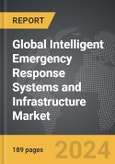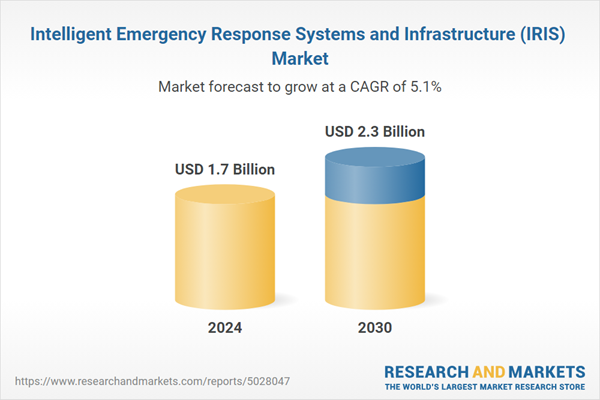The global market for Intelligent Emergency Response Systems and Infrastructure (IRIS) was valued at US$1.7 Billion in 2024 and is projected to reach US$2.3 Billion by 2030, growing at a CAGR of 5.1% from 2024 to 2030. This comprehensive report provides an in-depth analysis of market trends, drivers, and forecasts, helping you make informed business decisions. The report includes the most recent global tariff developments and what they mean for your business.
Segments: Type (Life Security, Physical Security, Facility Management Security, Other Types); System (Surveillance Systems, Broadcasting Systems, Signage, Perimeter Intrusion Systems, Other Systems); End-Use (Government, Industrial, Healthcare, Defense, Other End-Uses).
Geographic Regions/Countries: World; United States; Canada; Japan; China; Europe (France; Germany; Italy; United Kingdom; and Rest of Europe); Asia-Pacific; Rest of World.
The analysts continuously track trade developments worldwide, drawing insights from leading global economists and over 200 industry and policy institutions, including think tanks, trade organizations, and national economic advisory bodies. This intelligence is integrated into forecasting models to provide timely, data-driven analysis of emerging risks and opportunities.
Global Intelligent Emergency Response Systems and Infrastructure (IRIS) Market - Key Trends & Drivers Summarized
What Are Intelligent Emergency Response Systems and Infrastructure (IRIS) and Why Are They Essential?
Intelligent Emergency Response Systems and Infrastructure (IRIS) are advanced solutions designed to enhance the efficiency and effectiveness of emergency response operations. These systems integrate various technologies, such as real-time data analytics, communication networks, and automated control systems, to provide a coordinated and timely response to emergencies, including natural disasters, industrial accidents, and security threats. IRIS are essential in today’s world as they significantly improve the ability of emergency services to manage crises by providing accurate, real-time information that supports decision-making. These systems are particularly vital in urban areas, critical infrastructure, and industrial facilities, where the consequences of delayed or uncoordinated responses can be severe. As the frequency and complexity of emergencies increase, the deployment of IRIS is becoming increasingly important for safeguarding lives, property, and critical infrastructure.How Are Technological Innovations Shaping the IRIS Market?
Technological innovations are playing a pivotal role in shaping the IRIS market, particularly through advancements in communication technologies, artificial intelligence (AI), and data integration. The development of advanced communication networks, including 5G, is enabling faster and more reliable transmission of data between emergency responders, control centers, and the public, ensuring that critical information is disseminated quickly and efficiently. AI and machine learning are being used to analyze vast amounts of data from multiple sources, such as sensors, surveillance cameras, and social media, to provide real-time insights that can guide emergency response strategies. Additionally, the integration of Geographic Information Systems (GIS) with IRIS is enhancing situational awareness by providing detailed, real-time maps that display the locations of assets, hazards, and personnel. The use of drones and autonomous vehicles in emergency response is also transforming the market by enabling rapid assessment of disaster zones and delivery of essential supplies to areas that are difficult to reach. These technological advancements are driving the development of more sophisticated and effective IRIS solutions, which are increasingly being adopted by governments, municipalities, and private sector organizations.Why Is There an Increasing Demand for IRIS Across Various Sectors?
The demand for intelligent emergency response systems and infrastructure is increasing across various sectors due to the growing need for more effective and coordinated emergency management strategies. In urban areas, where the density of population and infrastructure amplifies the impact of disasters, the adoption of IRIS is essential for managing the complexities of large-scale emergency responses. The industrial sector, particularly in high-risk environments such as chemical plants, oil refineries, and nuclear facilities, is also seeing increased demand for IRIS to ensure the safety of workers and surrounding communities in the event of an accident. The rise of smart cities is further driving demand for IRIS, as these cities require integrated systems that can manage emergencies across multiple domains, from traffic management to public safety. Additionally, the growing threat of cyberattacks on critical infrastructure is leading to the adoption of IRIS as a means of enhancing resilience and ensuring that emergency response operations can continue even in the face of disruptions. As the frequency and severity of emergencies continue to rise, the need for advanced, intelligent systems that can enhance the speed and effectiveness of emergency responses is expected to drive further growth in the IRIS market.What Factors Are Driving the Growth in the IRIS Market?
The growth in the intelligent emergency response systems and infrastructure (IRIS) market is driven by several factors closely linked to technological advancements, urbanization trends, and increasing security threats. One of the primary drivers is the rapid urbanization and development of smart cities, which necessitate the integration of advanced emergency response systems to manage the complexities of densely populated areas. The increasing frequency of natural disasters, exacerbated by climate change, is also driving the demand for IRIS, as governments and organizations seek to improve their preparedness and response capabilities. The rise of industrialization in high-risk sectors is another significant factor, as these industries require robust emergency response systems to mitigate the risks associated with hazardous operations. Furthermore, the growing threat of terrorism and cyberattacks on critical infrastructure is pushing governments and private entities to invest in IRIS to ensure that they can respond effectively to these threats. As these factors continue to shape the global landscape, the demand for intelligent emergency response systems and infrastructure is expected to grow, driving further innovation and adoption in the market.Report Scope
The report analyzes the Intelligent Emergency Response Systems and Infrastructure (IRIS) market, presented in terms of units. The analysis covers the key segments and geographic regions outlined below.Segments: Type (Life Security, Physical Security, Facility Management Security, Other Types); System (Surveillance Systems, Broadcasting Systems, Signage, Perimeter Intrusion Systems, Other Systems); End-Use (Government, Industrial, Healthcare, Defense, Other End-Uses).
Geographic Regions/Countries: World; United States; Canada; Japan; China; Europe (France; Germany; Italy; United Kingdom; and Rest of Europe); Asia-Pacific; Rest of World.
Key Insights:
- Market Growth: Understand the significant growth trajectory of the Life Security segment, which is expected to reach US$1.0 Billion by 2030 with a CAGR of a 5.7%. The Physical Security segment is also set to grow at 5.2% CAGR over the analysis period.
- Regional Analysis: Gain insights into the U.S. market, valued at $476.1 Million in 2024, and China, forecasted to grow at an impressive 4.7% CAGR to reach $364.2 Million by 2030. Discover growth trends in other key regions, including Japan, Canada, Germany, and the Asia-Pacific.
Why You Should Buy This Report:
- Detailed Market Analysis: Access a thorough analysis of the Global Intelligent Emergency Response Systems and Infrastructure (IRIS) Market, covering all major geographic regions and market segments.
- Competitive Insights: Get an overview of the competitive landscape, including the market presence of major players across different geographies.
- Future Trends and Drivers: Understand the key trends and drivers shaping the future of the Global Intelligent Emergency Response Systems and Infrastructure (IRIS) Market.
- Actionable Insights: Benefit from actionable insights that can help you identify new revenue opportunities and make strategic business decisions.
Key Questions Answered:
- How is the Global Intelligent Emergency Response Systems and Infrastructure (IRIS) Market expected to evolve by 2030?
- What are the main drivers and restraints affecting the market?
- Which market segments will grow the most over the forecast period?
- How will market shares for different regions and segments change by 2030?
- Who are the leading players in the market, and what are their prospects?
Report Features:
- Comprehensive Market Data: Independent analysis of annual sales and market forecasts in US$ Million from 2024 to 2030.
- In-Depth Regional Analysis: Detailed insights into key markets, including the U.S., China, Japan, Canada, Europe, Asia-Pacific, Latin America, Middle East, and Africa.
- Company Profiles: Coverage of players such as Axis Communications AB, BlackBeery AtHoc Inc., Cobalt Inc., Denyo Co., Ltd., Eaton Corporation PLC and more.
- Complimentary Updates: Receive free report updates for one year to keep you informed of the latest market developments.
Some of the 31 companies featured in this Intelligent Emergency Response Systems and Infrastructure (IRIS) market report include:
- Axis Communications AB
- BlackBeery AtHoc Inc.
- Cobalt Inc.
- Denyo Co., Ltd.
- Eaton Corporation PLC
- Enera Inc.
- Everbridge, Inc.
- Honeywell International, Inc.
- Micron Technology, Inc.
- Robert Bosch GmbH
- TOA Corporation
- UNI-PEX Co., Ltd.
- Visiplex, Inc.
Tariff Impact Analysis: Key Insights for 2025
Global tariff negotiations across 180+ countries are reshaping supply chains, costs, and competitiveness. This report reflects the latest developments as of April 2025 and incorporates forward-looking insights into the market outlook.The analysts continuously track trade developments worldwide, drawing insights from leading global economists and over 200 industry and policy institutions, including think tanks, trade organizations, and national economic advisory bodies. This intelligence is integrated into forecasting models to provide timely, data-driven analysis of emerging risks and opportunities.
What’s Included in This Edition:
- Tariff-adjusted market forecasts by region and segment
- Analysis of cost and supply chain implications by sourcing and trade exposure
- Strategic insights into geographic shifts
Buyers receive a free July 2025 update with:
- Finalized tariff impacts and new trade agreement effects
- Updated projections reflecting global sourcing and cost shifts
- Expanded country-specific coverage across the industry
Table of Contents
I. METHODOLOGYII. EXECUTIVE SUMMARY2. FOCUS ON SELECT PLAYERS3. MARKET TRENDS & DRIVERSIII. MARKET ANALYSISIV. COMPETITION
1. MARKET OVERVIEW
4. GLOBAL MARKET PERSPECTIVE
UNITED STATES
CANADA
JAPAN
CHINA
EUROPE
FRANCE
GERMANY
ITALY
UNITED KINGDOM
REST OF EUROPE
ASIA-PACIFIC
REST OF WORLD
Companies Mentioned (Partial List)
A selection of companies mentioned in this report includes, but is not limited to:
- Axis Communications AB
- BlackBeery AtHoc Inc.
- Cobalt Inc.
- Denyo Co., Ltd.
- Eaton Corporation PLC
- Enera Inc.
- Everbridge, Inc.
- Honeywell International, Inc.
- Micron Technology, Inc.
- Robert Bosch GmbH
- TOA Corporation
- UNI-PEX Co., Ltd.
- Visiplex, Inc.
Table Information
| Report Attribute | Details |
|---|---|
| No. of Pages | 189 |
| Published | April 2025 |
| Forecast Period | 2024 - 2030 |
| Estimated Market Value ( USD | $ 1.7 Billion |
| Forecasted Market Value ( USD | $ 2.3 Billion |
| Compound Annual Growth Rate | 5.1% |
| Regions Covered | Global |









